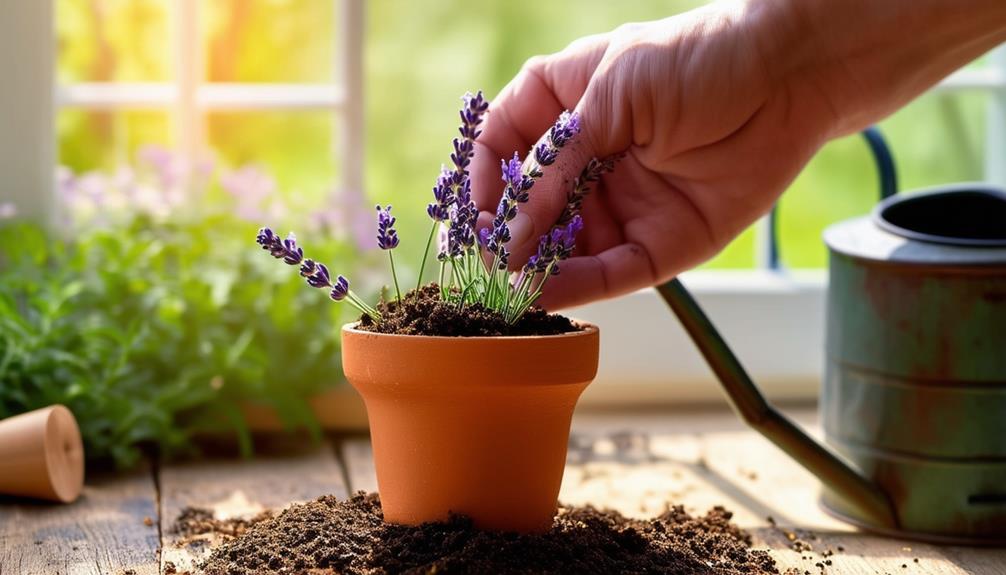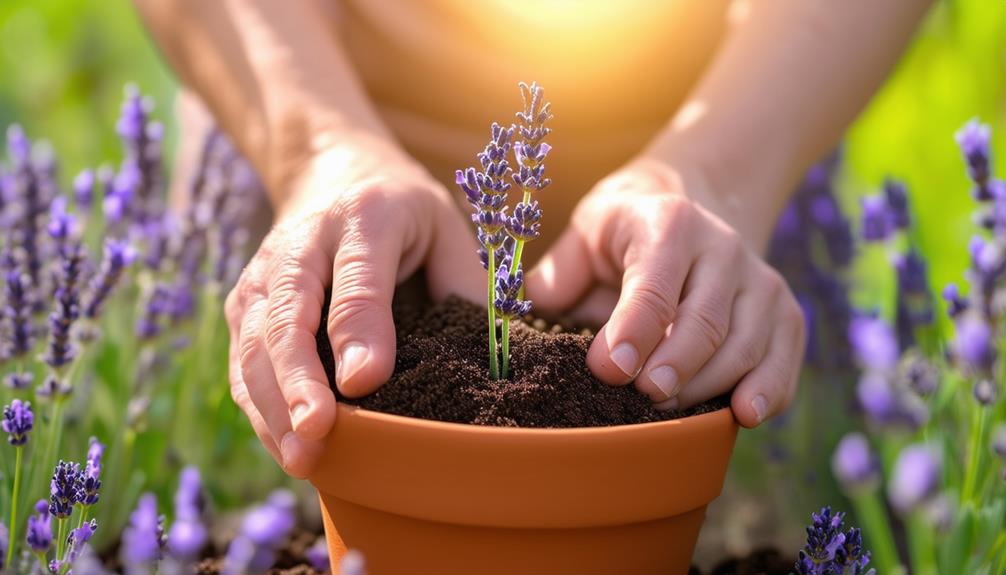How To Grow Lavender From Seeds

To successfully grow lavender from seed, it is essential to choose seeds that are well-suited to your local climate and soil conditions. Ensure that the soil has good drainage and is slightly alkaline for optimal growth. A blend of potting soil and sand that drains well is recommended for planting the seeds.
Keep the soil slightly moist, avoiding waterlogging, to support the germination process. Start by planting the seeds indoors in a warm, sunny location and water them gently.
Once the seedlings emerge, provide them with plenty of sunlight, water only when the soil is dry, and be cautious of preventing root rot. For a comprehensive guide on effectively nurturing your lavender plants for successful growth, refer to the complete resource. Please follow the following steps if you decide growing lavender from seed indoor
Key Takeaways
- Select lavender seeds that are well-suited to the specific climate and soil conditions in your area.
- Prepare a soil mix that is well-draining by adding sand to promote optimal germination.
- Start by sowing the seeds indoors in trays, ensuring they are kept warm and receive indirect sunlight for proper growth.
- Once the last frost has passed, transplant the seedlings to a sunny location with good drainage in the soil.
- Harvest the lavender before it reaches full bloom, dry the flowers for culinary purposes, and regularly prune the plant to maintain its health.
Choosing the Right Lavender Seeds
When selecting the appropriate lavender seeds for your garden, choose varieties that are well-suited to your local climate and soil conditions. Different lavender seeds are tailored to specific growing environments, so consider factors like sunlight exposure, soil composition, and average temperatures in your region. These elements significantly impact the successful germination and cultivation of your lavender plants.
Ensure the soil you use for planting the seeds has good drainage. Lavender plants prefer soil that doesn't retain excess moisture, so opt for a light, sandy soil mix that facilitates water flow. Additionally, lavender seeds thrive in slightly alkaline soil with a pH level ranging between 6.7 and 7.3 for optimal growth.
When picking out lavender seeds, take into account how you intend to propagate them. Some varieties are suitable for direct sowing in the garden, while others may require indoor germination before being transplanted. Understanding the germination and propagation preferences of the lavender seeds you select will help you create the perfect conditions for their growth and maturation. By choosing the right lavender seeds that match your specific environment, you increase the chances of establishing a flourishing lavender garden.
Preparing for Seed Germination
To prepare for successful seed germination of lavender, it's essential to understand the specific requirements of the seeds you have chosen. Lavender seeds thrive in well-draining soil to prevent waterlogging and root rot. Create an optimal soil mix by combining potting soil with sand to ensure proper drainage. The soil should be slightly moist but not excessively wet, as too much moisture can impede germination.
Maintaining the right moisture levels is crucial for successful germination. Keep the soil consistently moist, but avoid overwatering. Check the soil moisture by feeling it with your fingers – it should be slightly damp, not soggy. Balancing the moisture levels is key to supporting the germination process effectively.
Proper soil composition and moisture management are vital for successful lavender seed germination. By providing the ideal environment for your seeds, you set the stage for healthy seedling growth. Understanding the specific needs of lavender seeds increases the chances of successful propagation. Next, we'll delve into sowing the seeds indoors to continue nurturing their growth.
Sowing Seeds Indoors
To successfully sow lavender seeds indoors, gather the necessary materials: lavender seeds, seed trays, well-draining soil, and a warm, indirectly lit spot. Fill the seed trays with soil, leaving space at the top. Evenly sow the lavender seeds on the soil surface, lightly pressing them in. Cover with a thin soil layer and water lightly, ensuring the top layer remains moist. Maintain soil moisture levels during germination to prevent drying out.
Create a mini greenhouse effect by placing the seeded trays in a plastic bag to retain moisture and warmth. Keep the trays in a warm area, ideally around 70 degrees Fahrenheit, for germination. After a few weeks, seeds should start sprouting. Once germinated, remove the plastic bag and move the trays to a spot with bright, indirect sunlight. Water the seedlings gently, allowing the soil to slightly dry between waterings to prevent root rot. Providing proper care during germination and early growth stages is crucial for successful lavender propagation indoors.
Providing Optimal Growth Conditions
To optimize the growth of your lavender seedlings post-germination, it's crucial to provide them with the ideal growing conditions. Begin by selecting well-draining soil that's lightweight and airy, such as a blend of potting mix and perlite. This type of soil will prevent water accumulation around the roots, minimizing the risk of issues like root rot.
Position your seedlings in a spot where they can access ample sunlight. If you're cultivating lavender indoors, consider utilizing grow lights to supplement natural light. Lavender plants flourish in full sun, so aim to expose them to at least 6-8 hours of bright light daily.
Maintaining appropriate moisture levels is vital for the prosperity of your lavender seedlings. Water them when the top layer of soil feels dry to the touch, ensuring not to overwater. Adequate drainage is essential to prevent waterlogged soil, which may result in root rot.
Transplanting Seedlings Outdoors

When transitioning your lavender seedlings from indoor containers to an outdoor garden bed, it's important to acclimate them gradually to their new surroundings to support healthy growth.
Timing is Key: Wait until after the last frost date in your region before transplanting your lavender seedlings outside. This will protect them from potential damage caused by cold temperatures.
Select an Ideal Planting Location: Choose a sunny spot in your garden with well-draining soil and good air circulation. Lavender thrives in such conditions, increasing the likelihood of successful growth.
Handle with Care: Delicately remove the seedlings from their containers, taking care not to disturb the roots excessively. Dig a hole in the garden bed slightly larger than the seedling's root ball. Place the seedling in the hole and gently backfill with soil, ensuring to eliminate any air pockets by patting it down.
Transferring your lavender seedlings outdoors can be a gratifying process as you witness their development and flourishing in their new environment. By adhering to these guidelines and providing optimal conditions, you can aid in the establishment of robust root systems and the production of vibrant blooms.
Caring for Young Lavender Plants
To foster the optimal growth and vibrant blossoming of young lavender plants, create a nurturing environment. Lavender thrives in well-draining soil that isn't overly fertile. Ensure the soil has a slightly alkaline pH level ranging from 6.7 to 7.3. To prevent root rot, allow the soil to dry out between watering intervals when tending to young lavender plants. Water deeply but infrequently to promote a strong root system.
Place your lavender seedlings in a sunny location where they can bask in a minimum of 6 to 8 hours of sunlight daily. If cultivating lavender indoors, consider using grow lights to supplement light needs. Adequate air circulation is essential for young lavender plants, so avoid overcrowding them.
As your lavender plants mature, occasional pruning may be necessary to stimulate denser growth and increased flowering. Lightly prune the plants in the spring, removing faded flowers and shaping the plant as desired. Avoid late-season pruning to prevent new growth that may not have time to mature before winter sets in.
Managing Pests and Diseases

To protect your lavender plants from potential harm, it's crucial to regularly inspect and address any issues related to pests and diseases. Follow these tips for effective management and prevention:
Regular Monitoring: Conduct frequent inspections of your lavender plants to check for pests like aphids, spider mites, or diseases such as root rot or powdery mildew. Early detection is key to addressing problems before they escalate.
Natural Solutions: Utilize natural remedies to combat pests and diseases on your lavender plants. For instance, consider introducing beneficial insects like ladybugs to control aphids or using a neem oil solution to treat fungal infections.
Optimal Plant Spacing: Ensure that your lavender plants are adequately spaced apart to encourage proper air circulation. Adequate spacing helps prevent the onset of diseases like powdery mildew, which thrive in moist and congested environments.
Harvesting and Using Lavender Flowers
Harvesting and using lavender flowers is a delightful way to enjoy the aromatic essence of your lavender plants. Lavender flowers not only enhance the fragrance of your garden but can also be utilized in various creative ways, such as crafting potpourri, sachets, or incorporating them into culinary delights like lavender lemonade or lavender-infused cookies.
| Task | Description |
|---|---|
| Harvesting | Cut lavender stems just before full bloom to capture the best fragrance. Hang bundles to dry in a dark, dry place. |
| Pruning | Trim back spent flower stems to promote new growth and more blooms. Pruning also aids in maintaining the plant's shape and health. |
| Culinary Use | Enhance baked goods, syrups, or herbal teas with lavender flowers for a unique and aromatic flavor. Use sparingly as it is potent. |
Frequently Asked Questions
Can Lavender Seeds Be Stored for Future Use?
Yes, you can preserve lavender seeds for future use by storing them in a cool, dry place inside an airtight container. This will help maintain their viability for planting at a later time.
How Do I Protect My Lavender Plants From Extreme Heat?
To protect your lavender plants from high temperatures, ensure they receive adequate watering without becoming waterlogged. Apply mulch around the base to retain moisture and minimize evaporation. Provide shade during the hottest parts of the day to prevent wilting and promote healthy growth.
Is It Necessary to Prune Lavender Plants Regularly?
Regularly pruning lavender plants is crucial for maintaining their health and encouraging new growth. Trim back spent blooms and woody stems to stimulate the growth of fresh foliage. This practice also prevents the plant from becoming leggy, improves air circulation, and promotes overall plant vigor.
Can Lavender Plants Survive in Humid Climates?
In humid climates, lavender plants may struggle due to the excess moisture. To help them thrive, make sure to provide good drainage, adequate air circulation, and a sunny location. With proper care, your lavender can adjust and grow beautifully.
What Are Some Creative Ways to Use Harvested Lavender Flowers?
Explore creative ways to use freshly harvested lavender flowers! Create fragrant sachets for drawers, incorporate petals into homemade soap, infuse honey for a sweet flavor, or craft soothing lavender oil. The aromatic possibilities for your lavender harvest are endless.
Conclusion
Now that you've mastered the art of growing lavender from seed, you're all set to embark on your fragrant gardening journey!
Just like a delicate flower seeking the sunlight, your lavender plants will flourish with the proper care and attention.
So, get your hands dirty, nurture your plants, and witness your lavender garden transform into a captivating oasis of colors and scents.
Search
Categories
Recent Posts
Follow US
https://sites.google.com/view/gardeningfire
https://www.youtube.com/@Gardening-Fire
https://twitter.com/gardeningfire
https://www.instagram.com/gardeningfire/
https://www.facebook.com/GardeningFire/
https://www.tumblr.com/gardeningfire
https://gardeningfire.blogspot.com/
https://gardeningfire.wordpress.com/
https://www.pinterest.com/gardeningfire/
https://soundcloud.com/gardeningfire/